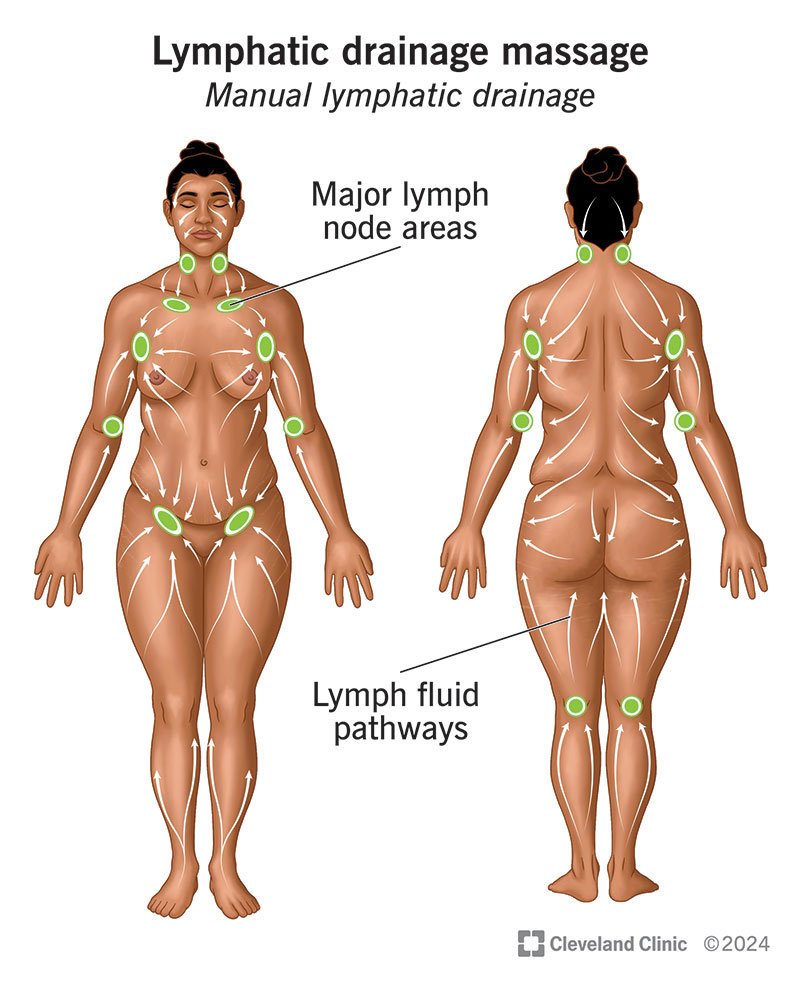Lymphatic drainage massage relieves swelling that occurs when illness or medical treatment clogs your lymphatic system. Lymphatic massage involves gently manipulating specific areas of your body to move excess fluid buildup away from your tissues and toward working lymph vessels and lymph nodes so they can get rid of toxins in your body.
Advertisement
Cleveland Clinic is a non-profit academic medical center. Advertising on our site helps support our mission. We do not endorse non-Cleveland Clinic products or services. Policy
Lymphatic drainage massage is a gentle form of massage used to relieve inflammation related to lymphedema. Lymphedema is a common side effect of many health conditions. It’s also common among people recovering from cancer treatments, most notably, breast cancer surgery because surgeons remove several lymph nodes during the procedure.
Advertisement
Cleveland Clinic is a non-profit academic medical center. Advertising on our site helps support our mission. We do not endorse non-Cleveland Clinic products or services. Policy
Typically, your lymphatic system collects your lymph and returns it to your heart via a network of vessels and nodes. When something disrupts this process, lymph collects in your arms, legs, ankles or other parts of your body, making them swell.
A massage therapist uses lymphatic drainage techniques to move lymph from your tissues to your lymph nodes, which eases the swelling.
Healthcare providers mainly use manual lymphatic drainage to relieve lymphedema after breast cancer surgery. They also use it to treat lymphedema related to health conditions like:
Lymphatic massage is also a popular cosmetic treatment. Facial lymphatic drainage may increase blood circulation and reduce puffiness in your face, giving your skin a glowing boost.
Lymph drainage massage can help if your lymphatic system isn’t working as it should. You might have a congested lymph system if you develop:

During lymph drainage, a healthcare provider will use light pressure and strategic massage techniques to prepare and clear your lymphatic system. The session usually starts with a massage to stimulate the areas of your body that house your lymph nodes. This means a healthcare provider will massage your armpits, neck and, with your consent, your groin area. Next, they’ll coax excess lymph fluid from your swollen tissues toward your lymph nodes, where the lymph can reabsorb.
Advertisement
Lymphatic massage may reduce swelling in your body and make it easier for your lymph nodes to get rid of toxins. Lymphatic drainage massage benefits may include:
For many people, lymphatic massage is a safe way to relieve lymphedema. But you should avoid it if you have:
Healthcare providers won’t do lymph drainage massage directly over cancerous tissue or skin that’s damaged from radiation therapy.
Few people have negative reactions to lymphatic massage. But some people develop side effects like fatigue, headaches or nausea. If this happens, let your healthcare provider know. They can tell you how to reduce your risk for these complications.
You might not see immediate results from lymph drainage massages. If you have several sessions without noticeable improvement, ask your healthcare provider about alternative treatments.
You can do lymphatic draining massage on yourself at home in some cases. But before you attempt it, ask your healthcare provider how to do it properly. Depending on your situation, you might still need to work with a trained massage therapist.
Lymphatic massage can be quite helpful if you have lymphedema. But it shouldn’t be your only treatment. If you wear compression garments (like socks or sleeves) to reduce fluid retention, you should keep wearing them.
Lymphatic massage may not work for everyone. If you don’t have lymphedema, you may not see meaningful results. But it’s not dangerous in most cases either.
You should call your provider any time your lymphedema symptoms get worse. This includes things like puffiness in your belly, tightness in your joints or swelling in your arms or legs.
Occasional fluid buildup might not slow you down too much. But if you have persistent swelling in your arms, legs, belly or other areas, it can take a toll. Your limbs might feel tired and heavy. Your skin might feel tight or uncomfortable. Your favorite clothes or jewelry might not fit.
Whether a health condition or medical treatment caused lymphedema, lymphatic drainage massage could be a valuable aspect of your care plan. It’s not right for everyone, though. If you’re curious about lymphatic massage, talk to your healthcare provider.
Advertisement
A breast cancer diagnosis can turn your world upside down. At Cleveland Clinic, we offer expertise, compassion and personalized treatment plans.

Last reviewed on 09/19/2024.
Learn more about the Health Library and our editorial process.